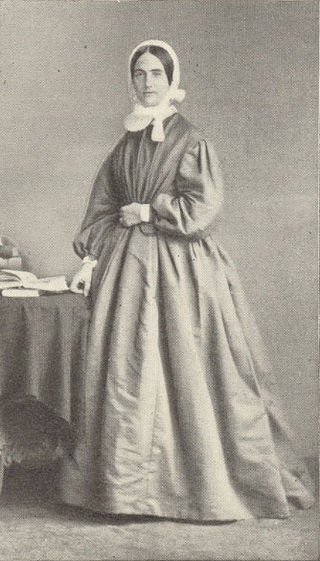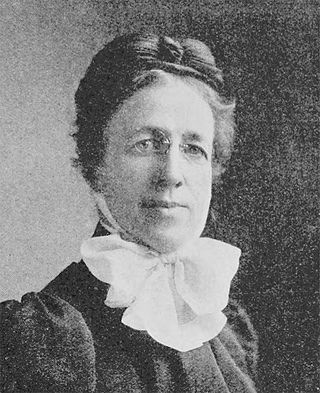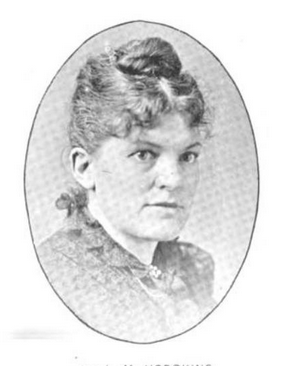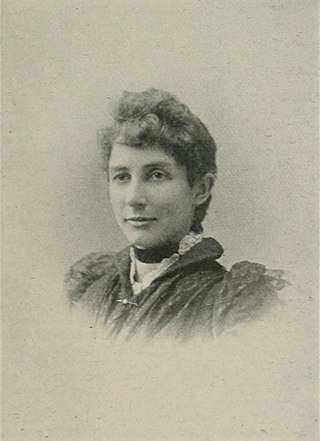
Jane Marie Bancroft Robinson (December 24, 1847 - May 29, 1932) was an author and educator.

Jane Marie Bancroft Robinson (December 24, 1847 - May 29, 1932) was an author and educator.
Jane Marie Bancroft was born in West Stockbridge, Massachusetts, on December 24, 1847. She descended on her mother's side, Caroline J. Orton, from an old Dutch family of New York City, and on her father's side from early English settlers in New Jersey. Her father, Rev. George C. Bancroft, was for over fifty years a member of the Methodist Episcopal Church. [1] [2]
Bancroft graduated in 1871 from the Troy Female Seminary, founded by Emma Willard. In 1872 she graduated from the State Normal School in Albany, New York, and immediately there-after was appointed preceptress of Fort Edward Collegiate Institute, Fort Edward (town), New York, where she remained until 1876. [1]
During the years from 1870 to 1876, colleges for women were being established, and the doors of colleges hitherto open only to men were thrown open to women. Urged by her far-sighted mother, Jane Bancroft determined to take a college course. While in Fort Edward, she took private lessons in advanced studies, and in the fall of 1876 entered Syracuse University as a member of the senior class, and was graduated from that institution in 1877. [1]
In 1907, she was elected to Phi Beta Kappa society, and received two honorary doctorates, in 1919, from Syracuse University and in 1929, from the University of Southern California. [2]
Immediately after graduation from Syracuse University, Jane Bancroft was invited to become the dean of the Woman's College of the Northwestern University in Evanston, Illinois, and professor of the French language and literature, a position previously occupied by Frances Willard and Ellen Soule Carhart. She founded the Western Association of Collegiate Alumnae, an early model of the American Association of University Women. [1] [2]
In addition to the arduous work of the position, she diligently pursued her studies in French history, with a view to taking a higher degree, and she received from Syracuse University, upon examination, the degree of Ph. M. in 1880, and of Ph. D. in 1883. Her thesis for the latter degree, A Study of the Parliament of Paris and Other Parliaments of France was a treatise on the parliament of Paris and other parliaments of France, and the research and study therein displayed won her at once a fine reputation. It was published in 1884. Many of the leading historical students in the United States and England sent her appreciative letters. [1] [2]
In 1885 she resigned her position in the Northwestern University to pursue historical studies as a fellow of history in Bryn Mawr College, the first recipient of the history fellowship at that institution. In 1886 she went to Europe, matriculated in the University of Zurich, and remained there one year, devoting herself to the study of political and constitutional history. The following year she went to Paris and became a student in the Paris-Sorbonne University, continuing her researches in history. She was also received as a student in the École pratique des hautes études, being the first woman to hear lectures in the literary department of that school. [1] [2]
Her stay abroad was diversified by travel and writing. She contributed to various papers and periodicals. Visiting London before her return to the United States, she became deeply interested in the deaconess work as illustrated in different institutions there and studied it carefully. She returned to the United States, convinced that that social and religious movement might prove a great agency in the uplifting of the poor and the degraded of her native land. Her wide information and executive ability were at once pressed into service for developing deaconess work in the United States, where it had already gained a foothold. [1]
At the invitation of its officers, in 1888 she took full charge of the department of deaconess work in the Woman's Foreign Missionary Society of the Methodist Episcopal Church. She visited most of the large cities of the United States, speaking in behalf of the deaconess cause, and interesting the women of different Protestant churches by means of parlor meetings and public lectures. She was a logical and fluent speaker as well as a writer of marked talent. From 1908 to 1913 she was the president of the Woman's Home Missionary Society. [1] [2]
In 1889 she published her most important work, entitled "Deaconesses in Europe and their Lessons for America," which was the leading authority in the United States upon the subject. [1]
She was the secretary of the Bureau for Deaconess Work of the Woman's Home Missionary Society. She was a life member of the American Historical Association and of the American Economic Association. She was connected with many philanthropic and social organizations. [1]
In 1891 Jane Bancroft became the wife of Hon. George Orville Robinson (1832-1915), of Detroit, Michigan, a lawyer, widely known in philanthropic and legal circles. He was the founder of the Michigan Christian Advocate and aided his wife's work by giving generously to the construction of deaconess institutions. [1] [2]
Three years after the death of her husband in 1915, she moved with her half-sister Henrietta Ash Bancroft (October 26, 1842 - February 10, 1929) in Pasadena, California. [2]
She died in Pasadena, California, on May 29, 1932, and is buried at Mountain View Cemetery and Mausoleum, Altadena, California. [2]
Jane Bancroft Robinson more than $10,000 ($165,364.38 in 2017) to the California Institute of Technology in Pasadena, California. She donated her home and land for the construction of retirement homes for deaconesses and ministers. [2] [3]

Frances Elizabeth Caroline Willard was an American educator, temperance reformer, and women's suffragist. Willard became the national president of Woman's Christian Temperance Union (WCTU) in 1879 and remained president until her death in 1898. Her influence continued in the next decades, as the Eighteenth and Nineteenth Amendments to the United States Constitution were adopted. Willard developed the slogan "Do Everything" for the WCTU and encouraged members to engage in a broad array of social reforms by lobbying, petitioning, preaching, publishing, and education.

The ministry of a deaconess is a usually non-ordained ministry for women in some Protestant, Oriental Orthodox, and Eastern Orthodox churches to provide pastoral care, especially for other women, and which may carry a limited liturgical role. The word comes from the Greek diakonos (διάκονος), for "deacon", which means a servant or helper and occurs frequently in the Christian New Testament of the Bible.

Theodor Fliedner was a German Lutheran minister and founder of Lutheran deaconess training. In 1836, he founded Kaiserswerther Diakonie, a hospital and deaconess training center. Together with his wives Friederike Münster and Caroline Bertheau, he is regarded as the renewer of the apostolic deaconess ministry. His work in nursing was pioneering for Florence Nightingale, who spent a few months in Kaiserswerth in 1850.

Elizabeth Catherine Ferard was a deaconess credited with revitalising the deaconess order in the Anglican Communion. She is now remembered in the Calendar of saints in some parts of the Anglican Communion on either 3 or 18 July.

Harriet Bedell was an Episcopal deaconess and missionary to the Cheyenne in Oklahoma, Alaska Natives, and the Seminole of Florida. She is remembered on the calendar of saints of the Episcopal Church in the United States of America on January 8.
Joan Elizabeth Spencer-Smith (1891–1965) was a notable New Zealand Anglican deaconess and lecturer. She was born in London, London, England in 1891. Her brother was the Rev. Arnold Spencer-Smith chaplain and photographer to Shackleton's Imperial Trans-Antarctic Expedition.
Jessie Alexander was a New Zealand Presbyterian deaconess and missionary.
Chicago Training School for Home and Foreign Missions was a training school in Chicago for missionaries associated with the Methodist Church. It was founded by Lucy Rider Meyer and her husband Josiah in 1885 and was described as "the largest training school of its kind in the country" and awarded the degree of Bachelor of Religious Service (BRS).

Lucy Webb Hayes National Training School was a religious training school, now a hospital, in Washington, D.C. So named in memory of Lucy Webb Hayes, the wife of former President Rutherford B. Hayes. It was founded in 1891 and was the authorized training school of the Woman's Foreign Missionary Society of the Methodist Episcopal Church, which owned the property of the school, exercised supervision and jurisdiction over its management, and looked to it to supply the trained workers employed by the society in its widely diversified fields of labor. The privileges of the school were not, however, confined to those connected with the Woman's Home Missionary Society. It opened its doors to all who wanted to prepare themselves for any department of Christian activity. In 1894, the school was chartered by act of Congress in conjunction with the Deaconess Home and Sibley Memorial Hospital, and formed with them one corporation. The unified administration and guaranteed the training of Christian workers.

Lucy Jane Rider Meyer was an American social worker, educator, physician, and author who cofounded the Chicago Training School for City, Home, and Foreign Missions in Illinois. She is credited with reviving the office of the female deacon in the U.S. Methodist Episcopal Church.
Henry Harrison Straight was an American geologist, professor, second president of Peru State College, and the father of investment banker and diplomat Willard Dickerman Straight.

Louise Manning Hodgkins was an American educator, author, and editor from Massachusetts. After completing her studies at Pennington Seminary and Wilbraham Wesleyan Academy, she became a teacher and preceptress at Lawrence College, before receiving a Master of Arts degree from that institution in 1876. She taught at Wellesley College for over a decade before turning her attentions to writing and editing. Her main works included Nineteenth Century Authors of Great Britain and the United States, Study of the English Language, and Via Christi. She served as editor of The Heathen Woman's Friend, the first organ of the Woman's Foreign Missionary Society of the Methodist Episcopal Church, and also edited Milton lyrics : L'allegro, Il penseroso, Comus, and Lycidas and Matthew Arnold's Sohrab and Rustum. She died in 1935.

Clara Bradley Baker Wheeler Burdette was an American clubwoman and philanthropist based in Pasadena, California. She was the first president of the California Federation of Women's Clubs.
Helen Margaret Aitken Reid, also known by her married surname Reid-Martin, was a New Zealand religious leader. She was the first woman in New Zealand to be ordained as a Presbyterian minister, and the second woman to serve as moderator of the General Assembly of the Presbyterian Church of Aotearoa New Zealand.
Dorothy Edna Genders (1892–1978) was an Australian charity worker and a deaconess in the Anglican Church of Australia. Known as "Sister Dorothy," she was notable for being one the first women to graduate with a Licenciate in Theology in Australia. She provided pastoral care, taught Sunday school, and trained candidates for the deaconess role. She also established and managed housing for vulnerable women. In East Perth, she turned the church rectory into a refuge for women survivors of domestic violence and prostitution. In Cottesloe, she opened a home for the destitute. She died in 1978, in Subiaco, a suburb of Perth.

Marion Macfarlane was the first woman to be ordained in the Anglican Church in Australia. She was ordained to the "Female Diaconate" in 1884 in the Diocese of Melbourne, then in 1886 converted to Catholicism, took the name Sister Mary Euphrasia, and joined the Sisters of the Good Shepherd.
Mary Andrews was an Anglican Deaconess, missionary and church leader.
Mary Schleicher (1855-1949) was the first deaconess in the Anglican Diocese of Sydney, appointed in 1886 to Newtown parish.

Florence E. Kollock was an American Universalist minister and lecturer. She organized and served as pastor of the Stewart Avenue Universalist Church, Chicago, 1878–92. She subsequently served as pastor of the Universalist Church, Pasadena, California, 1892–95, where, with a membership of nearly 500, it was the largest congregation in the world under the charge of a woman. From 1904 till September 1910, she was the pastor of St. Paul's Universalist Church, Jamaica Plain (Boston), Massachusetts. Kollock served as President of the Woman's Centenary Association,, 1902–3. She lectured extensively in the U.S. and abroad on sociological and philanthropic problems. She was prominent in all reformatory and educational work, including the temperance movement and women's suffrage.

Emma Winner Rogers was an American writer and speaker upon economic and social questions, and on the Arts and Crafts movement. She favored suffrage, and served as an officer of the National American Woman Suffrage Association. Among her published works can be counted Deaconesses in the early church. Deaconesses in the modern church. (1891), The social failure of the city (1898), The Journal of a Country Woman (1912), and Why not complete the enfranchisement of women (1912).
{{cite book}}: CS1 maint: multiple names: authors list (link) CS1 maint: numeric names: authors list (link)